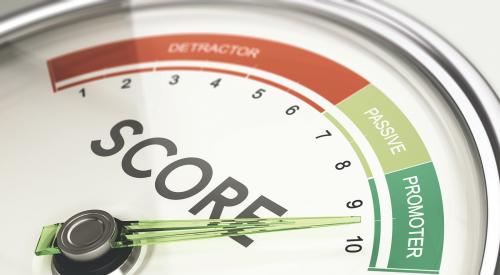Reichheld determined there is one customer question that will determine a business's ability to grow: How likely are you to recommend XYZ Company to family and friends? Using a 0-10 scale, with 10 being very likely to recommend, companies are able to determine their Net Promoter Score by subtracting the percentage of customers who are detractors (those who answered 0-6) from the promoters (those who answered 9 or 10). The 7s and 8s, which have a neutral impact on the company's growth, are ignored in the calculation.
Our industry incorporated this tool in 2006, when Avid Ratings integrated Net Promoter Score in its Customer Loyalty Management Program. The tool categorizes homeowner survey responses by how likely the buyer is to make referrals.
Recently, the Net Promoter Score and Reichheld's research have come under attack. In a July 2007 article in the Journal of Marketing, the authors describe how their replication of Reichheld's research yielded no concrete evidence that Net Promoter Score was better at indicating future business success than other measures. The article states, "using industries Reichheld sites as exemplars of Net Promoter, the research fails to replicate his assertions regarding the 'clear superiority' of Net Promoter compared with other measures."
Coding Individual Buyers
This did not come as a surprise to us; our Referral Potential score differs from Net Promoter in that it examines the individual's rather than the organization's overall referral index. We built the tool so that home builders could identify individuals who have a high probability of making referrals, those who are neutral, and those who are likely to make negative referrals. By coding individual buyers, builders are able to design targeted follow-up marketing based on each buyer's Referral Potential. This is much more effective than building a single marketing strategy around a composite score for the entire organization.
We found that buyers who indicated they would make referrals were not doing so at the same rate. What prompted some "promoters" to make more referrals than others was the level of their overall experience. Those customers who had referral intentions and a great experience made the most referrals, whereas those who had referral intentions but a mediocre experience made fewer referrals.
Simply put: Although Reichheld's Net Promoter is an important theoretical contribution, it's only one piece of the equation. A holistic-practical approach to measuring customer delight and loyalty clearly yields more Net Sales for builders than those using Net Promoter or doing nothing at all. Indeed, having the right information is what it takes to succeed in today's market.
Cardis' Tips
Distinguish
Although Fred Reichheld's Net Promoter is an important theoretical contribution, it's only one piece of the equation. Be careful when making causal relationships with just one question.
Market
To boost referrals, target customers who are likely to make recommendations and are extremely delighted with their buying experience.
Delight
Because overall customer delight is a key factor in making referrals, emphasize it throughout the entire buying process.
Invest
Because referred prospects are twice as likely to buy than regular prospects, invest more resources in generating referrals.
Paul Cardis is CEO of Avid Ratings Co., a research and consulting firm specializing in customer satisfaction for the home-building industry. He can be reached at paul.cardis@avidratings.com.











